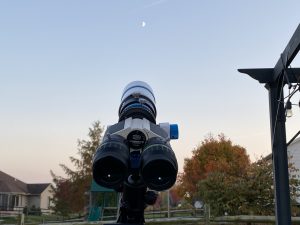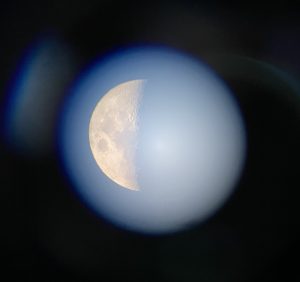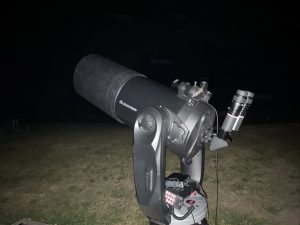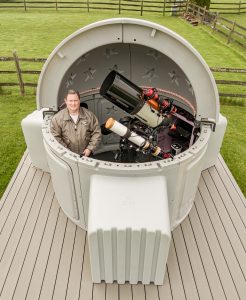It was turning into a beautiful evening as the summer sun was beginning to set. The sound of children’s laughter competed for the chirping of crickets as they took advantage of the warm breeze and late summer sunset.
 To the southeast, mighty Jupiter and noble Saturn were beginning to become visible as they started their evening transit, shining bright in the sky as they chased the setting sun in the beautiful darkening skies. The moon was following quickly behind, and I wanted to start the evening viewing planets before the moonlight affected the viewing (Image 1).
To the southeast, mighty Jupiter and noble Saturn were beginning to become visible as they started their evening transit, shining bright in the sky as they chased the setting sun in the beautiful darkening skies. The moon was following quickly behind, and I wanted to start the evening viewing planets before the moonlight affected the viewing (Image 1).
The heat of the day was beginning to dissipate as I began to set up my gear for a night of both visual and astrophotography. Thankful for the breeze that was beginning to chase the heat away from the evening air. I was hopeful that I would achieve the trifecta of clear skies, no wind and low humidity. A rare event in NW Ohio as we are in the jet stream flow from the great lakes. Heavy moisture and clouds are common as are strong prevailing winds – strong in the sense that mount and scope vibration can be consistent factors.

My anticipation was building as the goal for the evening was to focus on the experience of an evening of visual viewing. I went into the evening with both eyes open to the adventure at hand – literally. I would still be setting up for an astrophotography session on my main gear – mounted in my SkyShed POD… but tonight it would be, for me, a throwback to an earlier era, a night of under the stars visual viewing with the Baader MaxBright II Binoviewer. I would not be disappointed (Image 2).
After slewing the scope toward Jupiter, I leaned into the binoviewer with anticipation – WOW, the 4 Galilean moons and the atmospheric banding were immediately evident. Crystal clear views met both eyes after a few adjustments for simultaneous focus were achieved. Switching the view to Saturn, I was in love – immediately I was swept back in time to my first “real” telescope… circa 1980 something…
A good friend and I have a shared childhood love of astronomy and science and in college we had an opportunity to buy a Tasco 70mm

refractor from Service Merchandise – on a GEM. No motorized mount, old school to be sure but the package came with a variety of eyepieces and a Barlow lens. I had this telescope until recently – it got knocked over and broken by movers.
I mention this because as many readers can understand, one of the first objects we turned the scope to after the Moon was Saturn. Seeing the rings of Saturn was life altering – certainly, it cemented an interest into a lifelong passion.
Back to the task at hand, rewind to earlier in the day. I took some time to open and sort through the adapters and was spent working out how to connect the Baader MaxBright II Binoviewer to one of my telescopes. This is not specifically a challenge but as nearly all my scopes are set up for photography and finding a good match that would allow for achieving focus and a comfortable viewing position turned out to be more trial and error.
I have been fortunate enough to be asked to write a non-paid review of these amazing products and I have been eagerly awaiting the opportunity to find the weather and the time that would provide a stress-free viewing session (Image 3).

The quality of the product is immediately clear, the included hard case is a great addition. I’ll get into some of the technical details of the product but as a user, the quality of manufacturing is evident when you pick them up. There is a solid feel to them, the non-slip leather finish, the stainless steel, the self-centering locks all speak to the durability and value of the product. Less apparent features like the optics and coatings factor into the viewing results.
I setup on an Astro-Tech AT-70ED 2.8” F/6 refractor as my Explore Scientific EXOSII-PCM8 mount could handle this setup with no issues and is low enough to terra firma that I could view without fatigue.
The manual is comprehensive and features a great many additional accessories to ensure you can connect the Binoviewer to any system and achieve great results for any number of viewing scenarios including the option for solar viewing. The manual also has step by step instructions for configuring the various accessories. It’s well written and worth a read before you sit down to use the Binoviewer for the first time (See Images 4 and 5).

The MaxBright II Binoviewer kit that I am using contains a Zeiss microbayonet (dovetail ring), a spanner tool to fix T-2 adapter or Zeiss Microbayonet to the Bino-viewer. I also added a glass path corrector and a 1.25” nosepiece as my Barlow is 1.25”.
As part of my setup that I have not used in operation yet is the Baader FlipMirror II, star diagonal – I am really looking forward to using this on a dual imaging/viewing rig. My initial tests in connecting my ZWO camera were successful just ensure you have the proper adapter. For my review I received several spacers and adapters and finding the correct setup was a breeze.
Paired with the Binoviewer were two Baader MORPHEUS 76° Eyepieces (17.5mm). The field of view and the clarity of these eyepieces was stunning. I have not used a wide variety of eyepieces – my jump has been from plastic and cheap to moderate to the MORPHEUS Eyepieces. It’s fair to mention that this was the most impressive visual setup I have used (Image 6).

Once the moon was above the neighbor’s house, I put a 2x Barlow into my William Optics GT-102 and connected the Binoviewer. I looked, adjusted focus and leaned back from what I had just witnessed. After a few moments of contemplation, I went into the house to get my wife. I’ve lost count of how many times I’ve gone into the house to share a moment… a view this stunning must be shared right?
She came out like the trooper she is and took her first look through the Binoviewer – her reaction: WOW, it does not even look real! Understand that I have had nice astronomy gear for a while, and she has seen the moon and other objects many times through various scopes over the years but always with a single eyepiece. I’m typing knowing that the visual astronomy community is probably smiling and laughing having a user cross back over from the astrophotography side to the beauty and serenity of being outside under the stars using the Mark One Eyeball for a change.

For my next session, I met up with a group from the Toledo Astronomical Association for a night of viewing. With much anticipation, we were able to mount the Binoviewer on an 11” Celestron. I was excited for this meeting as I knew that there were some seasoned visual observers that could provide some additional input on the quality of the setup having used many products over the years (Image 7).
Holy cow. Amazing. That’s incredible, we’re all responses. Shock at the price was also discussed. A lot of detailed discussion about the optics and supported field of view with various eyepieces that I’ll do more detail digging for recommendations.
Seeing the moon transits across Jupiter and the red spot with such clarity was again an amazing experience along with the detail of Saturn. Most impressive to me were the globular clusters. They look 3D. I’ve never seen that before. We hit quite a few targets and seeing conditions were as good as we get here.
 Having the ability to do visual astronomy using the Baader MaxBright II Binoviewer with both eyes open was a refreshing change, a chance to be outside under the stars without the other distractions of computers, data acquisition and processing… a world I know and have loved but have been away from for a while. This was a journey back to another time, certainly a simpler time.
Having the ability to do visual astronomy using the Baader MaxBright II Binoviewer with both eyes open was a refreshing change, a chance to be outside under the stars without the other distractions of computers, data acquisition and processing… a world I know and have loved but have been away from for a while. This was a journey back to another time, certainly a simpler time.
Having the best of both worlds on a beautiful evening was smile worthy and a good reminder of why I got into this hobby – no – this passion – in the first place. The amazing world we have available to us if we simply look up. It’s achievable if we just stop for a minute and turn away from the insanity – if we are able… to contemplate the place we occupy in this blue marble floating through the heavens.
###
 Author of this article John Crisp is the VP of Digital for The Blade/Block Communications managing software architecture. His “Astro Product Reviews” website – www.astroproductreviews.com – provides informative product unboxing, reviews & how to videos for products relating to astronomy and astrophotography. His other hobbies include the design, building and flying of experimental aircraft and radio control aircraft – his main pride and Joy is a kit built Fokker Dr-1 Triplane and has a Piper Cub (3/4 Scale that he is designing and building). His Private Pilots Certificate has been active since 1987 and photography and astrophotography are a few other passions.
Author of this article John Crisp is the VP of Digital for The Blade/Block Communications managing software architecture. His “Astro Product Reviews” website – www.astroproductreviews.com – provides informative product unboxing, reviews & how to videos for products relating to astronomy and astrophotography. His other hobbies include the design, building and flying of experimental aircraft and radio control aircraft – his main pride and Joy is a kit built Fokker Dr-1 Triplane and has a Piper Cub (3/4 Scale that he is designing and building). His Private Pilots Certificate has been active since 1987 and photography and astrophotography are a few other passions.
And to make it easier for you to get the most extensive news, articles and reviews that are only available in the magazine pages of Astronomy Technology Today, we are offering a 1 year magazine subscription for only $6! Or, for an even better deal, we are offering 2 years for only $9. Click here to get these deals which only will be available for a very limited time. You can also check out a free sample issue here.



